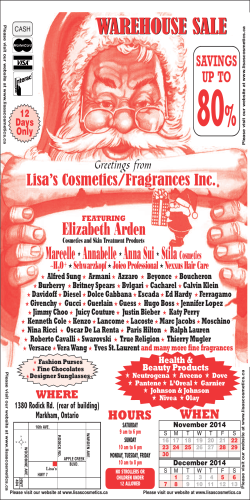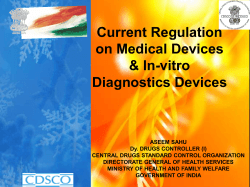
Untitled - Evan Healy
6 Morning Myst Fruitland, Washington What an Aromatic Herb Farmer Taught Me About Sustainable Beauty For the first time in history, the goal of medical intervention is not restitutio ad integrum or restitutio ad optimum, but rather the . . . enhancement of the human body. —Wolfgang Harth, Kurt Seikowski, and Barbara Hermes, “Lifestyle Drugs in Old Age” (2008) and herb farmer Annie Harman cuts an impressive figure even with her two feet planted firmly on the ground. Standing high on the dais of the distilling shed, her silver hair one with a great cloud of steam, her long, bony arm thrust deep into the belly of a gleaming copper still, she looked otherworldly. Perhaps this vision was somewhat heightened by the eighty pounds of freshly harvested chamomile we’d distilled that morning. In the warm June air, the herb’s sweet molecules filled the shed and saturated my brain, leaving me in a sublime, slack-jawed reverie. I stood Green witch Farmacology_i_xiv_1_290.indd 193 2/21/13 5:17 PM 194 fa r mac o l o g y there passively while Annie performed one of the last steps in the distillation process—draining her Dr. Seuss-like alembic stills and throwing the thoroughly stewed herbs into the bucket of her front-loader. From there the plant material would be composted and returned to the soil. Meanwhile, the results of our efforts—eight gallon-size jerry cans filled with an Easter-egg-blue floral water, or hydrosol—sat neatly arranged on the shed’s floor. “You see,” Annie said, plunging her face into the steam to pull out an armful of chamomile, “I get a great facial every time I do this.” Earlier that day, I’d asked her how she managed to have such smooth and dewy skin—especially for a fifty-two-year-old—and this was part of the answer. But only one part. Over the next few days, my brown notebook would slowly fill with beauty tips—gems I’d traveled all the way to Morning Myst Farm, in the outer reaches of Washington State, to collect. Misadventures in Beautyland This last farm adventure was sparked by something highly personal and, in the scheme of things, shamefully trivial: a dark, caterpillar-shaped discoloration on my upper lip. I’m not sure if it appeared overnight or had been developing for some time, but I finally noticed it when on the eve of my forty-sixth birthday I was inspired to lean in a bit closer than usual to my bathroom mirror. Once seen, there was no ignoring the melasma, the medical term for skin that is hyper-pigmented, generally as a result of hormonal changes and too much sun. The mark, strikingly bracketed by the parentheses of my deepening smile lines, was all I saw whenever I caught my reflection. My husband claimed he couldn’t see it at all. But then, he was the guy who kept telling me I was gorgeous when, at the end of my first pregnancy, I was so swollen that my eyes were reduced to slits and bedroom slippers or extra-wide Tevas were the only footwear option. Only later, and under Farmacology_i_xiv_1_290.indd 194 2/21/13 5:17 PM M o r n i n g M yst 195 much duress, did he finally admit that I was less than comely during that third trimester. “Oh, that’s nothing,” said my friend Sharon when I casually asked her about my melasma. “I had really dark spots on my forehead and looked like Gorbachev.” Sharon showed me a tube of lightening cream she’d been prescribed by her dermatologist, telling me that it had served her well. I looked at the ingredients: a dastardly trio of high-potency steroid, Retin A, and a bleaching agent called hydroquinone. At that moment, a cautionary inner voice reminded me of a promise I’d made to myself years earlier never to go down the slippery slope of medical cosmetic treatments. But how easy it is to be dogmatic when you have unblemished skin and nary a wrinkle! Surely a mustache-like stain was grounds for breaking that commitment. After all, it wasn’t as if I’d just scheduled a facelift. So hours later I was applying my own (self-prescribed) lightening cream, blithely ignoring the fact that the hydroquinone has been banned in Europe as a cosmetic because it causes cancer in rats. At first, things went well. I could see the darkness fading, replaced with a color that was a shade lighter than my normal skin, yet this seemed like an improvement. But then, as I neared Week Three of my regimen, I started to notice a new, less attractive reddish hue around my upper lip. Anxious to finish my treatment, I stifled my instincts to stop and pushed on for one more week. Much to my horror, two days later I awoke to discover that the faint red had become beefy red, and the rash had spread to around my nose and to my chin, far from where I had been applying the cream. It looked like a bumpy crimson muzzle. I took a picture of these latest developments and e-mailed it (along with lots of dramatic punctuation) to a dermatologist friend. Her response came back in minutes: perioral dermatitis, a grab-bag diagnosis that physicians apply to pimply rashes in the vicinity of the nose and mouth. And while the dermatology literature says that in most cases the cause is unknown, I knew for certain that mine was caused by vanity and an overly potent skin whitener. Farmacology_i_xiv_1_290.indd 195 2/21/13 5:17 PM 198 fa r mac o l o g y Any desperation I felt upon discovering the melasma paled in comparison to what I now felt. My kids said “ew” when I appeared at breakfast, and patients cringed as I drew near to examine them, clearly fearing that I might be contagious. Even my husband had a hard time pretending he couldn’t see it. My dermatologist friend wrote, “The only thing that helps is antibiotics,” so I promptly started myself on three weeks’ worth of a slow-release tetracycline. The drugs caused misery from day one. They gave me knife-sharp cramps after eating and a metallic taste in my mouth, and in combination with a glass of wine, they triggered one of the worst headaches of my life. But I kept going, because the eruption on my face seemed to get better with each passing day. Alas, twenty-four hours after I stopped the antibiotics, the rash and burning returned full force. Once again I sent the dermatologist an emergency e-mail. “I hate to say it,” she wrote back, “but you may need to take the antibiotics for longer, and there’s still no guarantee it won’t come back.” Suddenly I felt foolish. What was I thinking? I, who weigh all options before prescribing even a topical antibiotic or a low-dose steroid cream to a patient, had blithely put myself on weeks of a powerful steroid (plus retinoid and hydroquinone), followed by weeks of an oral antibiotic. There had to be another way. I pulled out a reference book titled Aromadermatology written by Janetta Bensouilah, an acupuncturist/aromatherapist in the United Kingdom. I’d found it some time ago while browsing the Internet and was impressed by the caliber of scientific research on which she had based her recommendations. As the name implies, it’s a book about treating skin conditions with plant essences or aromatherapy, and I’ve consulted it often to successfully treat a variety of skin problems—from eczema in children to acne in teens to psoriasis in adults. But somehow, with my own outbreak, it hadn’t occurred to me to look there. Now, I turned to the chapter on perioral dermatitis and rosacea, two rashes that are considered to be close cousins in the world of dermatologic afflictions. Farmacology_i_xiv_1_290.indd 198 2/21/13 5:17 PM M o r n i n g M yst 199 Bensouilah discusses how in both instances the stratum corneum (the skin’s barrier layer) is injured and the normal balance of skin flora is disturbed, with an overgrowth of certain bacteria and yeast and a disappearance of others. (In my case, one can presume that the heavy-duty drugs were responsible, but other potential triggers include exposure to extremes in weather, illness, or caustic cosmetics.) She notes that the triangular zone between the nose and mouth is particularly vulnerable to these rashes, since the stratum corneum here is thinner than on other parts of the face. This area also happens to have a slightly higher pH and to run warmer than elsewhere on the face, a condition that promotes unwanted bacteria and water loss, and makes the skin more prone to injury. (This explains why my friend Sharon could tolerate the cream on her forehead while my applications in the lip zone wreaked such havoc.) Bensouilah’s discussion of skin architecture sounded very familiar. I returned to my bookshelf and pulled out The Soul of Soil, one of the important books that started me on my quest to learn from farmers. I randomly opened to a page on soil management and read: Seedbeds are often created in a way that damages soil structure, resulting in erosion, compaction, and organic matter oxidation. For example, one common conventional method is fall moldboard plowing, spring dicing, and a final harrowing. The plow can create a hardpan with annual use, bury organic matter and living topsoil in an anaerobic zone, allow bare subsoil to erode by wind and water, and obstruct capillary action of water. The paragraph concludes with this: “The field may look good after the final harrowing, but not without great expense to soil tilth.” Since I’d spent time with Erick at Jubilee, I’d come to understand how closely we’re connected to the earth. But this was the first time I’d fully appreciated how much skin, the biggest organ in our body, mirrors the soil in Farmacology_i_xiv_1_290.indd 199 2/21/13 5:17 PM 200 fa r mac o l o g y structure and function: Both skin and soil have three major layers and a top protective layer of dead cells (the humus or the stratum corneum); each harbors microorganisms in the upper layers; each is responsible for exchanging water, vitamins and minerals, and gasses with the outside world; and each is constantly producing new structures, whether hair, sebum, or blades of grass. Just as the health of the soil offers a barometer for the health of the farm, our skin—our most visible organ—serves as a gauge of our overall health. There was no denying that right there between the lower border of my nose and the tip of my chin lay a highly overplowed and overtaxed plot of land. So, how to rebuild the stratum corneum? Bensouilah’s advice includes avoiding really spicy foods, sugar, alcohol, and citrus that may cause direct irritation around the mouth or increase the temperature or pH of the skin. She suggests protecting this zone from the elements with a wide-brimmed hat, or a broad-spectrum sunscreen, and avoiding extreme cold, wind, and high heat. Finally, and perhaps most important, she cautions against using the caustic or allergenic chemicals, such as alpha-hydroxy acids, mineral oils, parabens, phthalates, SLS (sodium lauryl sulfate) and artificial fragrances, that are often found in cosmetics, shampoo, toothpastes, hairsprays, cleansers, moisturizers, and many fragrances. Sadly, I found at least one ingredient from this list in just about every product in my bathroom— including my “organic” toothpaste. Then Bensouilah mentions hydrosols. She explains that these aqueous extracts are made from distilling whole plants and that one of their benefits, in addition to their cooling properties, is the astringent effect of the extract’s essential oil. However, unlike hydroxy acid or alcohol-based cleansers, which can exacerbate or even cause dermatitis and rosacea by stripping the skin of its natural oils, hydrosols remove dirt and debris but leave the protective skin layer intact. Bensouilah’s list of suitable hydrosols includes Roman chamomile (Anthemis nobilis), neroli (Citrus aurantium), rock rose (Cistus ladaniferus), lavender (Lavandula angustifolia), rose (Rosa damascena), and rose geranium (Pelargonium graveolens). Farmacology_i_xiv_1_290.indd 200 2/21/13 5:17 PM M o r n i n g M yst 201 Hydrosol . . . that sounded vaguely familiar. I rifled through the bottom drawer of my bathroom cabinet and found a glass atomizer, a gift from a friend. It came with no instructions, so I used it occasionally as a pleasant, although disappointingly ephemeral, room freshener. The clear fluid inside smelled of citrus and roses and the ingredient list was shockingly short: Pelargonium graveolens (rose geranium) hydrosol. Skeptical as I was, I decided I had nothing to lose and gave my face a generous misting. To my amazement, the burning disappeared almost immediately—so quickly that I wondered whether rose geranium had anesthetic properties. I went about my day, occasionally taking breaks to spray my face and then seal it in with shea butter, a thick emollient with no ingredients from Bensouilah’s danger list. Over the next few days, I boosted my diet with foods known to fight inflammation: onions and garlic, and three of my favorite spices—cloves, ginger, and turmeric. My skin swiftly improved—not completely back to baseline, but enough for me to feel confident that I was on the right track. Was it the hydrosols, the foods, or simply the fact that I had stopped doing caustic things to myself? Hard to know, but frankly, I didn’t care. At my local natural pharmacy, I looked for more hydrosols and I brought home a small but heady selection—lavender, chamomile, and more rose geranium—and continued to mist my way through the day. At some point, the rash completely disappeared, but I dared not stop my regimen for fear of a relapse. Also, I felt more fetching than I had in a long time—and calmer. People seemed to notice. Unsolicited, friends were telling me I looked great, and there seemed to be an uptick in the number of patients who casually asked for my healthy aging and beauty tips. Hand on the doorknob at the end of an appointment, they would say, “Oh by the way, what do you use on your face?” Was this all due to a hydrosol? I had no idea. Farmacology_i_xiv_1_290.indd 201 2/21/13 5:17 PM 202 fa r mac o l o g y Lessons from a Clinique Girl Turned Holistic Aesthetician Several weeks later, on a trip to San Diego, I decided to visit the woman behind evanhealy, the natural cosmetics company that bottled my first atomizer of hydrosol. The minute I laid eyes on the company’s founder and namesake, my instincts told me that she was someone who would offer uncomplicated beauty advice. Evan appeared to be in her mid to late fifties, and she glowed. Not with that lacquered look you get from overly stripped and tightened skin or glossy cosmetics, but with a soft light that seemed to come from within. As far as I could tell, she was still in possession of all her wrinkles and she wore hardly any makeup, save for the faintest of pink lipsticks that matched the pink of her silk kimono-style jacket. Her workshop/warehouse looked and smelled like a spa. In the main room, a handful of white-smocked employees sat at a long wooden table, listening to soothing music as they filled glass jars with creams and potions. They were working at a leisurely pace and seemed to take pleasure in handling the product. Evan introduced me to David, her husband and the head of marketing, whom she’d met years ago in a lavender field somewhere in the south of France, and then she led me into their sunny meeting room. There on the conference table were dozens of atomizers identical to those now occupying my own bathroom counter, my desk, the hand-wash station in my exam room, and even my purse. I told her about my recent experience with her hydrosols, and she smiled empathetically. “Between forty-six and fifty-six, the menopause years, we women are really on Mr. Toad’s wild ride. I was in LA a c ouple of weeks ago, and I sat with clients in Venice, Santa Monica, and Beverly Hills. Now, this is ground zero for the beauty industry, but these are a subset of women seeking a more natural alternative to injections and surgeries. Even among this group, they had the same mantra: ‘I don’t understand what’s going on with my skin.’ I look at their skin and it’s all buffed and polished—they’ve Farmacology_i_xiv_1_290.indd 202 2/21/13 5:17 PM M o r n i n g M yst 203 literally dissolved their epidermal layer with microderm products, alpha- hydroxy acids, and fruit enzymes.” Evan told me she’d started her cosmetics career years before as a “Clinique girl” at the I. Magnin department store. “I was selling products with all that junk,” she said, referring to the range of ingredients used by the L.A. women. That’s also what she used on her own face. In the mid-1980s, her father retired from his corporate job and moved to San Diego to open one of the first natural food markets in the area. He asked Evan to join him to head the cosmetics department, and so began her “wholesale conversion from Clinique to plants.” First she discovered Dr Haushka cosmetics from Germany, at the time a small, esoteric line. Haushka himself had studied under Rudolf Steiner (remember him from the Jubilee chapter?), and his products used botanicals that were grown and processed according to biodynamic principles and the rhythms of nature. In 1988, Evan got her aesthetician’s license and began treating clients with the Haushka products. But as she gained more hands-on experience, she noticed that they were not working for everyone. The line had exploded in popularity and she thought it was not being produced according to the high standards of the early years. Noticing the value of botanicals that were freshly harvested and in season, she began to incorporate locally grown plants into her beauty treatments. Eventually, she launched her own line of handmade, holistic cosmetic products. Her motto is “Farm to Face,” and her label reads, evanhealy the skin breathes. “The more I learned about personalities of the plants and the growing process, the more I realized that graceful aging was a matter of the soil,” Evan explained. “For example, like a wine, the lavender from 2010 had different notes than 2012. And these differences translate into different effects on the skin.” I asked for other tips for healthy aging, and she offered me the same suggestions I’d heard often enough and frequently dispensed myself: eat well, exercise, get a good night’s sleep, manage stress. Farmacology_i_xiv_1_290.indd 203 2/21/13 5:17 PM 204 fa r mac o l o g y “But you know,” she cautioned, “we have to get over our obsession with freshly minted body parts and let go of our white-knuckled grasp on youth. No one talks about beauty these days, they talk about anti- aging . . . anti-aging goes against nature. You can only hold your finger in the dike so long before the dam breaks. But feeling beautiful, you can do that at any age.” Then she got up and left the room, returning with another small diffuser. “This is Immortelle [Helichrysum] hydrosol, a special one. Really quite rare.” I misted my face: a little leather, a little tobacco, a little rose, a lot sexy. I was caught off guard by how intensely I was drawn to the smell. “I thought you’d like that one!” she said, laughing. “We live in such a complex world, and our skin needs not more complexity, but less. This plant doesn’t strip your skin or interfere with its own natural functions. It offers you a simple beauty.” “But how does it work?” I asked, fighting through the intoxicating effect of the Immortelle and trying to get back to the hard science. Thoughtful, she responded, “Well, I could say that the skin is a living organism and plants are living organisms. Or that we are a mediating influence between terra firma and the cosmos, born to receive and diffuse aromatic molecules. But of course, I don’t think that answer will satisfy the doctor in you.” She suggested that I visit the farmer who grows and distills her hydrosols, describing her as a walking herbal encyclopedia. That’s when I learned about Annie Harman. Morning Myst On my way north from Spokane, Washington, I cut through vast plains planted in wheat. It had been a mild June day when I left the airport, but here the crosswinds rattled my rental car. Occasionally the sea of grain was interrupted by a homestead—crouched behind a windscreen of poplar and fir. Farmacology_i_xiv_1_290.indd 204 2/21/13 5:17 PM
© Copyright 2025










